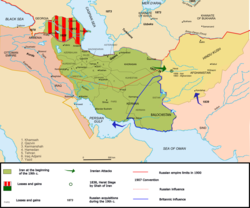Qajar dynasty
Iranian royal dynasty (1796–1925)
The Qajar dynasty (Azerbaijani: Qacarlar) (Persian: سلسله قاجار), was an Iranian dynasty[Note 1] that originated from the persian Qajar tribe. It ruled Iran from 1789 to 1925.
Sublime State of Iran دولت علیّه ایران | |||||||||||
|---|---|---|---|---|---|---|---|---|---|---|---|
| 1789–1925 | |||||||||||
| Anthem: (1873–1909) Salâm-e Shâh (Royal salute) (1909–1925) Salâmati-ye Dowlat-e 'Aliyye-ye Irân (Salute of the Sublime State of Iran) | |||||||||||
 Map of Sublime State of Iran in the 19th century. | |||||||||||
| Capital | Astarabad (1779–1789) Tehran (1789–1925) | ||||||||||
| Government | Absolute monarchy | ||||||||||
| Shah | |||||||||||
• 1789–1797 (first) | Mohammad Khan Qajar | ||||||||||
• 1909–1925 (last) | Ahmad Shah Qajar | ||||||||||
| History | |||||||||||
• Established | 1789 | ||||||||||
• Disestablished | 1925 | ||||||||||
| |||||||||||
Qajar Shahs of Iran
change| Name | Portrait | Title | Reign years | |
|---|---|---|---|---|
| 1 | Agha Mohammad Khan Qajar | Shah, Khan |
1789–1797 | |
| 2 | Fath-Ali Shah Qajar | Shahanshah, Khaqan |
1797–1834 | |
| 3 | Mohammad Shah Qajar | Shahanshah, Ghazi, Khaqan son of Khaqan |
1834–1848 | |
| 4 | Naser al-Din Shah Qajar | Shah, Zell'ollah, Qebleh-ye 'ālam, Islampanah |
1848–1896 | |
| 5 | Mozaffar ad-Din Shah Qajar | Shahanshah, Sultan |
1896–1907 | |
| 6 | Mohammad Ali Shah Qajar | Shah | 1907– 1909 | |
| 7 | Ahmad Shah Qajar | Shah | 1909–1925 | |
References
change- ↑ Amanat 1997, p. 2: "In the 126 years between the fall of the Safavid state in 1722 and the accession of Nasir al-Din Shah, the Qajars evolved from a shepherd-warrior tribe with strongholds in northern Iran into a Persian dynasty with all the trappings of a Perso-Islamic monarchy."
Sources
change- Amanat, Abbas (1997). Pivot of the Universe: Nasir Al-Din Shah Qajar and the Iranian Monarchy, 1831-1896. University of California Press. pp. 2. ISBN 978-0-520-08321-9.
In the 126 years between the fall of the Safavid state in 1722 and the accession of Nasir al-Din Shah, the Qajars evolved from a shepherd-warrior tribe with strongholds in northern Iran into a Persian dynasty with all the trappings of a Perso-Islamic monarchy.
- Yarshater, Ehsan (2004). "IRAN ii. IRANIAN HISTORY (2) Islamic period". Encyclopædia Iranica. Vol. XIII, Fasc. 3. p. 238–241.
The Qajar were a Turkmen tribe who first settled during the Mongol period in the vicinity of Armenia and were among the seven Qezelbāš tribes that supported the Safavids.

